I was recently invited over to Amos Rex, Helsinki to speak at the Museum Theme Days conference about digital participation. It was great couple of days with some really interesting peers working in Finland.
I thought I’d share some incomplete, sloppily captioned and edited slides from the lecture I gave which explore how and why digital participation is taking shape in the museum sector and how you can shape an active experience for visitors through the pedagogical lens of Constructionism.
Museums still maintain their role as social and civic places of learning – face to face interaction is still that perfect cherry we want to reach!

I want to talk about digital engagement and museums, but not about websites, apps and YouTube. But rather face to face encounters in hybrid spaces, where the walls of the galleries and collections meet with visitors, us, the museum staff and digital tools.
By creating these hybrid experiences of the tangible and digital worlds, we open up possibilities to expand the definition of what digital engagement is, allowing us to meet and to interact with our audiences in a much more personal manner and create active experiences. We have the opportunity to design experiences which change what people know, how they feel and to leave with new inspiration

When talking about digital trends, I often get asked, what is the next big thing, what will change over the next 10 years. I never get the question what is not going to change. And that second question is always more important of the two, one that you can build a strategy around and one which stays stable and useful over time. When something you know is true, even over the long term, you can afford to put a lot of energy into it.
I would suggest that in finding the core mission of your collection, your organisation – you are trying to find what the value for your visitors are. Many places forget this, but as public organisations for the people, we need to focus outward.
For me over the past few years this has been around inspiration, creativity and invention.
I came across this little note talking about creativity and thought that it summed it up well.
Being creative isn’t a superpower, you are not born with it and it is not exclusive. It isn’t magic – it is magical. We as museum educators, curators and programmers can help people tap into that.

In the UK, the dialogue around digital particiapation, in education and in government policy, is usually framed around the economy.
Over recent years there has been a drive to create a digitally skilled workforce coming from schools and universities who will drive the digital commercial sector. A key report from NESTA, the UK’s innovation strategy lab, worked with key drivers in the industry, from game companies, software developers and special effects for movies, to identify missing skillsets from the workers they needed. Although a number of the industries they spoke to could be classed as creative, the outcome was to implement a computer science currciuculum across all ages in schools which neglected the arts. By the age of 5, children should be able to define what an algorythm is and what it does. The curriculum has become very technically focussed.
But why should museums and galleries care about this?
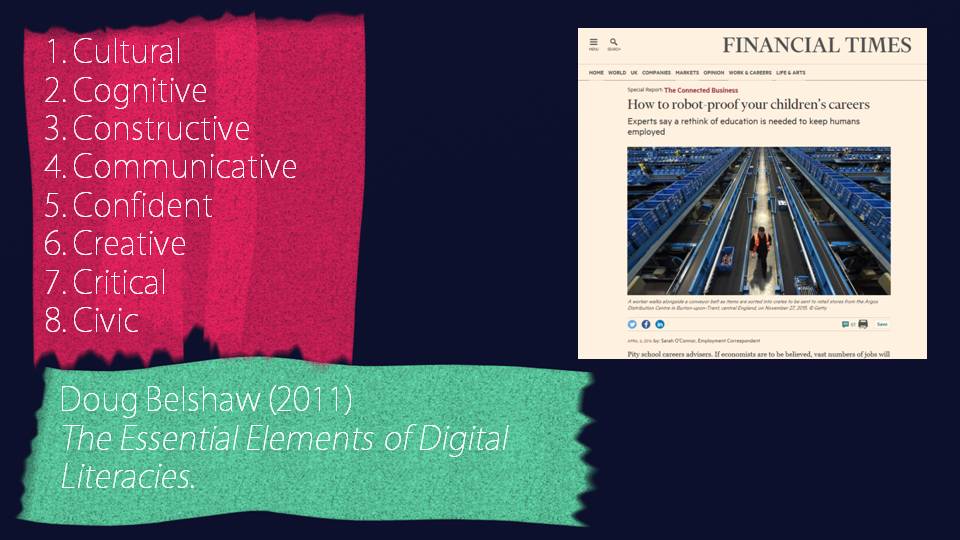
Well, culture and museums should care because digital literacy, engagement and creativity is multi-faceted and contains more than just technical aspects. Digital literacy eables artists to create spectacular creative visions – such as teamLab’s exhibition here, as well as understand, create and access the culture that museums and galleries put online.
What is the context of literacy? The differentiation of literate and illiterate is range of greys. It is a contested term encompassing creative and critical skills that allow creation, understanding and sharing meaning through digital media. There is no one umbrella term or definition but Belshaw’s model allows us to understand and recognise some of the key competencies involved.
Cultural – literacy is redefined as result of tech. change
Cognitive – Not ability to use tech tools but rather cognitive ones
Constructive – use and awareness of tools to enable constructive social action
Communicative – unique “rhetorics” of interactive communications
Confidence – the value put on those who can use tools to solve problems and manage their own learning
Creative – The creative adaption of tech and risk taking
Critical – literacy requires the critical reflection of digital media
Civic – Understanding the opportunities of civic participation thru ICT
Take a look at the article on the left of the screen. I came across this in the newspaper a while back. It talks about a Oxford University publication, “The Future of Employment: How susceptible are jobs to computerisation?” by Carl Benedikty Frey and Michael Osborne. It discussed and investigated the needs of workplaces and learners in a coming age where Artificial intelligence becomes a threat to the workforce. From that article, Andy Haldane, the Bank of Englad’s chief economist said:
“School education has tended to focus on developing the core cognitive competences — for example, reading, writing and arithmetic,”. “Smart machines have long since surpassed humans in their ability to do the first and third of these. And they are fast catching-up on the second. That begs the question of whether there are other skills where humans’ comparative advantage is greater.”
It identified three things which it proposed AI will not replace and what we need to be teaching. Can you for a second have think about what these might be?
Three things that AI/Machine Learning/Automation cannot replace:
Creativity
Empathy (Be nice)
Human dexterity

Alongside all this there is a renewed interest in Authenticity – an interest in traditional hand craft in a digital world.
This links to many pertinent factors, from sustainability to the desire to reclaim personal power in a world of mass production and mass media.
Things such as the repair manifesto talk of the power of repair. As it says, if you can’t fix it, you don’t own it. We all have technology in our pockets, little balck shiny boxes of our smartphones, but how many of us can say that we could fix a broken screen? Across many industries, the power to repair and modify products is being taken away as the become software based and filled with tighly controlled and patented software. There is a growing black market in agricutural machinery to allow farmers to hack their own tractors, ploughs and harvesters. Without this illegal technology, they have to use licensed suppliers, being expensive and taking their independence and market choice away. Repair is sustainable, we understand now that materials are limited, that the waste we create is poisoning the earth. If we can fix and understand our technology, we can make better use of our resources and gain useful skills along the way.
The same goes for craft. In the UK there is endless reality TV of competitions where people make ceramics, bake cakes and knit jumpers. These crafts may seem old fashioned, but people are rediscovering the joy of learning these skills and the wonderful feeling of being in a flow state as you do them.

So how do we bring some of these trends into galleries and use them as a way to engage people digitally? One way is to bring making in to museums and encourage people to be hands on with craft, and especially from my perspective, be hands on with craft and technology.
At the V&A the Digital Design Weekend was my largest event of the year and forms part of London Design Festival, For all audiences, it is a chance to meet and engage with contemporary digital artists, designers, makers and researchers. We invite in 50 or more artists to show their work in the galleries and to be there present alongside it.
Putting on the Digital Design weekend allows us a couple of key approaches to take in trying to engage our audiences in new ways through digital technologies.
Firstly, it created way for us to bring actual making back into the galleries. The act of craft – not just the outputs of it. We encourage work which is still in prototype stages or unfinished. It requires some confidence from those taking part to open up their processes and be vulnerable by sharing it.
Making is still something that happens in digital ways, it is still something which takes place in people’s sheds, in their offices, where ideas are experimented with, new approaches tried and creative solutions appear. It is just usually that with digital products, with online websites, apps or physical pieces of technology, the process is so opaque, so magical to those of us who are mere humans and not Bill Gates or Elon Musk, that we just see the end product. That product that is polished, perfect and market tested.
People still want to see the steps that lead up to the final thing. Still see the marks of the maker.

So in thinking of digital engagement, we need to think about what our audiences expect from their experience, that being the key word, and where we can meet them in the middle.
When thinking about our younger audiences, we spoke to them and came across the following findings which helped form the delivery of our work.
- Brands – Making – Collaboration
- Making and hacking is about sharing knowledge
- Digital tools and platforms are a space for self expression. Particularly important as young people are pushed out of the public sphere and spaces, the act of creating and discovering your identity happens online through digital tools.
- YP expect to be able to participate, shape and create media
- That the digital isn’t just something which happens on screens – it combines physical things and actions, which combine the two.

We wanted to create this kind of moment…a time when technology becomes magical, when that unexpected moment surprises and thrills you with the creative potential of technology.

In terms of how we frame this as educators, as learning specialists, we can theorise it around the pedagogy of Constructionism.
Constructionist learning is when learners construct mental models to understand the world around them but also use the process of learning as an opportunity to make things physically. “It is learning by constructing knowledge through the art of making something shareable”
Constructionism advocates student-centered, discovery learning where students use information they already know to acquire more knowledge. Students learn through participation in project-based learning where they make connections between different ideas and areas of knowledge facilitated by the teacher through coaching rather than using lectures or step-by-step guidance.
Further, constructionism holds that learning can happen most effectively when people are active in making tangible objects in the real world. In this sense, constructionism is connected with experiential learning and builds on Jean Piaget‘s epistemological theory of constructivism. Constructivism holds that individuals will bring their personal memories, interests and values to any learning or knowledge, and this makes the educator take on the role as a negotiator of subjective experiences. Constructionism says, lets take that personal experience and direct it into real world, physical making as a way to explore ideas together.
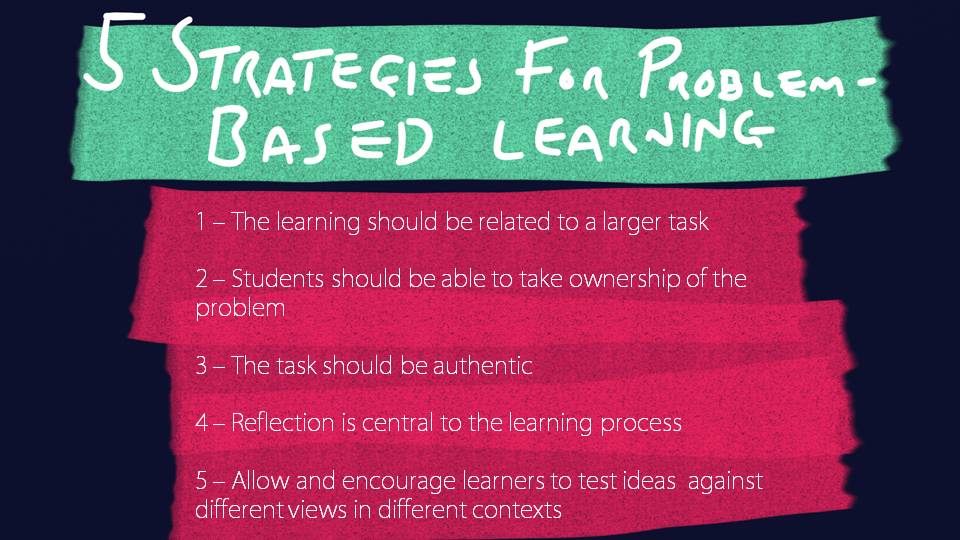
We can use the following five strategies make problem-based learning more effective, especially when planning workshops or events:
1 – The learning activities should be related to a larger task. The larger task is important because it allows students to see that the activities can be applied to many aspects of life and, as a result, students are more likely to find the activities they are doing useful.
2 – The learner needs to be supported to feel that they are beginning to have ownership of the overall problem.
3 – An authentic task should be designed for the learner. This means that the task and the learner’s cognitive ability have to match the problems to make learning valuable. The outputs of their work should be used to solve part of that problem.
4 – Reflection on the content being learned should occur so that learners can think through the process of what they have learned.
5 – Allow and encourage the learners to test ideas against different views in different contexts.
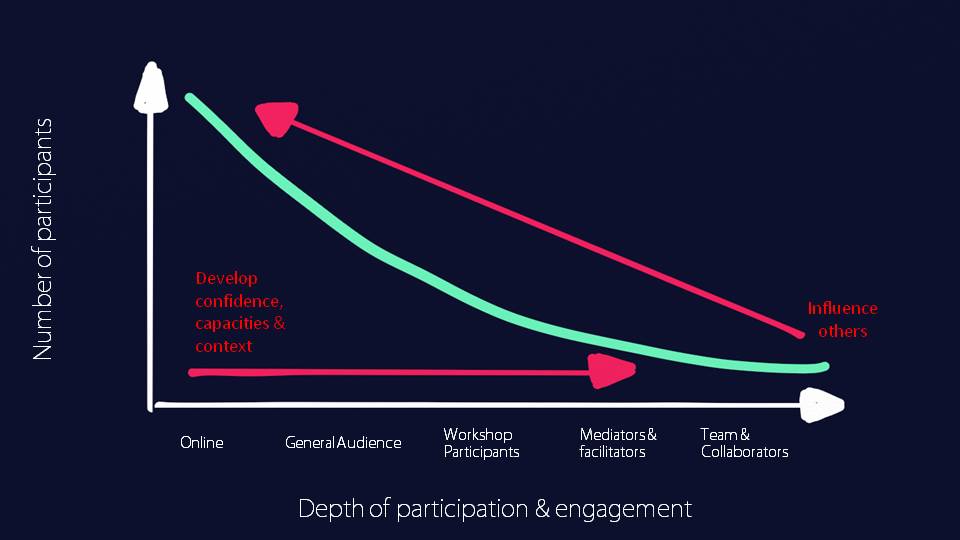
When we engage with people and think of participation we are really asking “What is the journey we want to take them on?”
Where their aims as visitors cross over with our’s as institutions lies an opportunity to design an experience which builds deeper engagement with each other.
This is a useful model of how scale effects participation and engagement and it can also be used as a road map as to where you want to take your audience once they engage with you. With the vast majority of online engagement, although the engagement with your audience is relatively low, attention spans short and interaction is limited, you are able to reach a lot of people. As we move along the horizontal X scale, the depth of our participation and engagement deepens, drawing the visitor and institution into a closer relationship.
When we think of our general audiences, their visits may be quite passive, with little interaction with the museum or gallery besides being there. Working within the galleries making, learning and doing opens the door to building deeper engagement. Through this we can develop the audiences confidence, in engaging with culture, their capacities, which may be their ability to interpret and understand the collections and topics on display or even if workshop based, their skills.
At the far end of the scale we have mediation, facilitation and teams and collaborators. For some organisations, this is where they want their audiences to be, the eventual aim of engaging them in the first place. This may include things such as co – design, collaborative curation or training and internships with a path to becoming an employee or volunteer within the museum.
With workshops and with making and doing within the galleries, we can also use this scale to think about what we are doing and why we are doing it. With family activities we may just want to add an experience to the family groups visit which creates a chance for dialogue. We may not want an in-depth “learning” experience for every visitor we engage with.
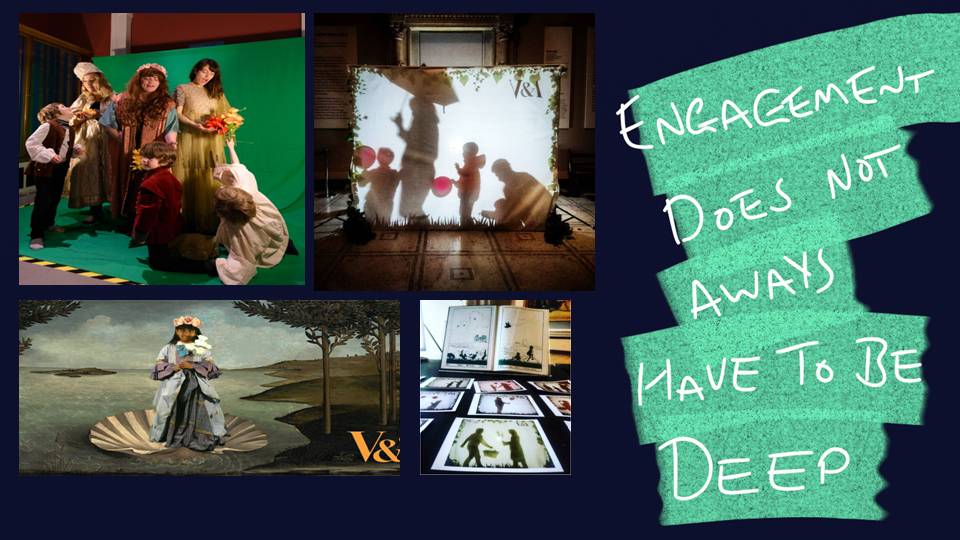

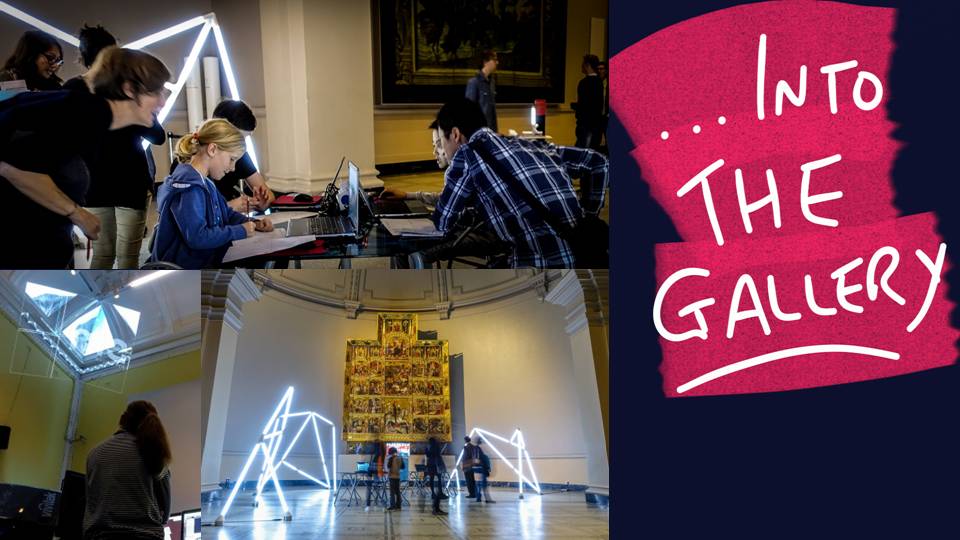
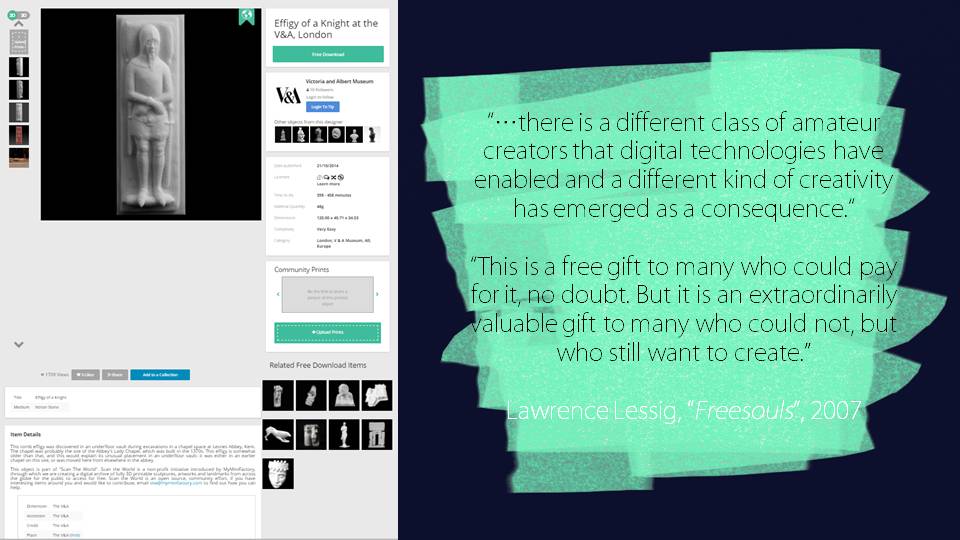
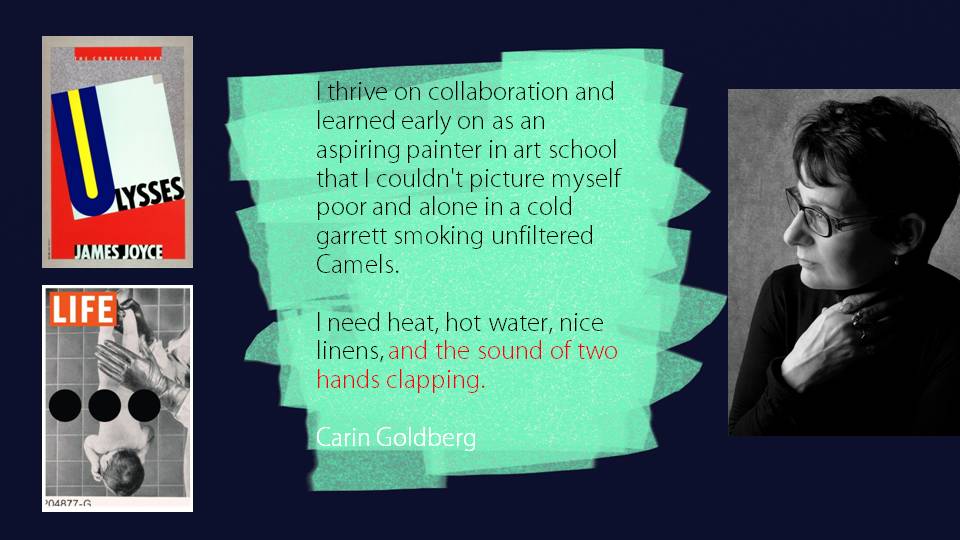
Coming back to that idea of asking – what things do not change. What are the most important things to you? I thought I would finish on this note from Carin Goldberg, the American graphic designer.
Giving support, giving validation as creatives, means a lot to everyone.
Digital engagement is more than your online presence, more than your social media and more than your memes.
